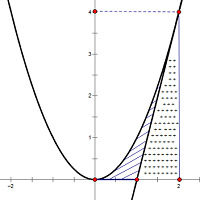Phương pháp giải phương trình có ẩn dưới dấu căn bậc hai-Kỹ thuật đổi biến không hoàn toàn
Kỹ thuật đổi biến không hoàn toàn là kỹ thuật sau khi đặt một phần biến cũ bằng biến mới. Phương trình tồn tại cả hai biến.
Kỹ thuật 1. Kỹ thuật đổi biến đưa về phương trình tích (Nhóm nhân tử chung).
Ví dụ
Giải phương trình: ${x^2} + \sqrt {x + 5} = 5,(1)$
Giải
Điệu kiện: $x \ge 5$. Đặt: $t = \sqrt {x + 5} ;t \ge 0$
$ \Leftrightarrow t = {x^2} + 5 \Leftrightarrow 5 = t – {x^2}$
(Lưu ý: Bước này gọi là bước chìa khóa cho phương pháp)
$\begin{array}{l}
(1) \Leftrightarrow {x^2} – {t^2} + x + t = 0\\
\Leftrightarrow \left( {x + t} \right)\left( {x – t} \right) + x + t = 0\\
\Leftrightarrow \left( {x + t} \right)\left( {x – t + 1} \right) = 0\\
\Leftrightarrow \left[ {\begin{array}{*{20}{c}}
{t = – x}\\
{t = x – 1}
\end{array}} \right.
\end{array}$
Với: $\begin{array}{l}
t = – x \Leftrightarrow \sqrt {x + 5} = – x\\
\Leftrightarrow \left\{ {\begin{array}{*{20}{c}}
{ – x \ge 0}\\
{x + 5 = {x^2}}
\end{array}} \right.\\
\Leftrightarrow \left\{ {\begin{array}{*{20}{c}}
{x \le 0}\\
{{x^2} – x – 5 = 0}
\end{array}} \right.\\
\Leftrightarrow \left\{ {\begin{array}{*{20}{c}}
{x \le 0}\\
{\left[ {\begin{array}{*{20}{c}}
{x = \frac{{1 + \sqrt {21} }}{2}}\\
{x = \frac{{1 – \sqrt {21} }}{2}}
\end{array}} \right.}
\end{array}} \right.\\
\Leftrightarrow x = \frac{{1 – \sqrt {21} }}{2}
\end{array}$
Với: $\begin{array}{l}
t = x + 1 \Leftrightarrow \sqrt {x + 5} = x + 1\\
\Leftrightarrow \left\{ {\begin{array}{*{20}{c}}
{x \ge – 1}\\
{x + 5 = {{\left( {x + 1} \right)}^2}}
\end{array}} \right.\\
\Leftrightarrow \left\{ {\begin{array}{*{20}{c}}
{x \ge – 1}\\
{{x^2} + x – 4 = 0}
\end{array}} \right.\\
\Leftrightarrow \left\{ {\begin{array}{*{20}{c}}
{x \ge – 1}\\
{\left[ {\begin{array}{*{20}{c}}
{x = \frac{{1 + \sqrt {17} }}{2}}\\
{x = \frac{{1 – \sqrt {17} }}{2}}
\end{array}} \right.}
\end{array}} \right.\\
\Leftrightarrow x = \frac{{1 + \sqrt {17} }}{2}
\end{array}$
Ví dụ 2:
Giải phương trình: $\sqrt {2 – x} = 2 – {x^2}$ (2)
Giải
Điều kiện: $x \le 2$. Đặt: $t = \sqrt {2 – x} ;t \ge 0$ $ \Leftrightarrow {t^2} = 2 – x \Leftrightarrow 2 = {t^2} + x$
$\begin{array}{l}
\left( 2 \right) \Leftrightarrow {t^2} – {x^2} + x – t = 0\\
\Leftrightarrow \left( {t – x} \right)\left( {t + x} \right) + x – t = 0\\
\Leftrightarrow \left( {t – x} \right)\left( {t + x – 1} \right) = 0\\
\Leftrightarrow \left[ {\begin{array}{*{20}{c}}
{t = x}\\
{t = 1 – x}
\end{array}} \right.
\end{array}$
* Với :$\begin{array}{l}
t = x \Leftrightarrow \sqrt {2 – x} = x\\
\Leftrightarrow \left\{ {\begin{array}{*{20}{c}}
{x \ge 0}\\
{{x^2} + x – 2 = 0}
\end{array}} \right.\\
\Leftrightarrow \left\{ {\begin{array}{*{20}{c}}
{x \ge 0}\\
{\left[ {\begin{array}{*{20}{c}}
{x = 1}\\
{x = – 2}
\end{array}} \right.}
\end{array}} \right.\\
\Leftrightarrow x = 1
\end{array}$
* Với: $\begin{array}{l}
t = 1 – x \Leftrightarrow \sqrt {2 – x} = 1 – x\\
\Leftrightarrow \left\{ {\begin{array}{*{20}{c}}
{x \le 1}\\
{2 – x = {{\left( {1 – x} \right)}^2}}
\end{array}} \right.\\
\Leftrightarrow \left\{ {\begin{array}{*{20}{c}}
{x \le 1}\\
{{x^2} – x – 1 = 0}
\end{array}} \right.\\
\Leftrightarrow \left\{ {\begin{array}{*{20}{c}}
{x \le 1}\\
{\left[ {\begin{array}{*{20}{c}}
{x = \frac{{1 + \sqrt 5 }}{2}}\\
{x = \frac{{1 – \sqrt 5 }}{2}}
\end{array}} \right.}
\end{array}} \right.\\
\Leftrightarrow x = \frac{{1 – \sqrt 5 }}{2}
\end{array}$
Lưu ý: Với cách đặt trên ta có thể trình bày dưới dạng hệ đối xứng hai ẩn. Tuy nhiên sau đó ta trừ về cho về thi phương trình trở về dạng tích.
Kỹ thuật 2. Kỹ thuật đổi biến đưa về hệ
Ví dụ
Giải phương trình: $2\sqrt[3]{{4x – {\rm{ 1}}}} = 8{x^3} + 1$ (1)
Giải
Đặt: $\left\{ {\begin{array}{*{20}{c}}
{u = 2x}\\
{v = \sqrt[3]{{4x – {\rm{ 1}}}} \Leftrightarrow {v^3} = 2u – 1}
\end{array}} \right.$
Khi đó: $(1) \Leftrightarrow \left\{ {\begin{array}{*{20}{c}}
{2v = {u^3} + 1\begin{array}{*{20}{c}}
{}&{}
\end{array}(2)}\\
{2u = {v^3} + 1\begin{array}{*{20}{c}}
{}&{}
\end{array}(3)}
\end{array}} \right.$
Trừ “vế” cho “vế” ta được:
$\begin{array}{l}
{u^3} – {v^3} = 2v – 2u\\
\Leftrightarrow \left( {u – v} \right)\left( {{u^2} + uv + {v^2}} \right) + 2(u – v) = 0\\
\Leftrightarrow \left( {u – v} \right)\left( {{u^2} + uv + {v^2} + 2} \right) = 0\\
\Leftrightarrow \left[ {\begin{array}{*{20}{c}}
{u = v}\\
{{u^2} + uv + {v^2} + 2 = 0}
\end{array}} \right.
\end{array}$
Với: $\begin{array}{l}
u = v \Leftrightarrow \sqrt[3]{{2u – {\rm{ 1}}}} = u\\
\Leftrightarrow 2u – 1 = {u^3}\\
\Leftrightarrow {u^3} – 2u + 1 = 0\\
\Leftrightarrow \left( {u – 1} \right)\left( {{u^2} + u – 1} \right) = 0\\
\Leftrightarrow \left[ {\begin{array}{*{20}{c}}
{u = 1}\\
{u = \frac{{ – 1 \pm \sqrt 5 }}{2}}
\end{array}} \right.\\
\Leftrightarrow \left[ {\begin{array}{*{20}{c}}
{x = \frac{1}{2}}\\
{x = \frac{{ – 1 \pm \sqrt 5 }}{4}}
\end{array}} \right.
\end{array}$
Với ${u^2} + uv + {v^2} + 2 = 0$, ta có:
$VT = \left( {{u^2} + 2u\frac{v}{2} + \frac{{{v^2}}}{4}} \right) + \frac{{3{v^2}}}{4} + 2 = {\left( {u + \frac{v}{2}} \right)^2} + \frac{{3{v^2}}}{4} + 2 \ge 2 > 0.(vn)$
Suy ra phương trình có nghiệm:
$\left[ {\begin{array}{*{20}{c}}
{x = \frac{1}{2}}\\
{x = \frac{{ – 1 \pm \sqrt 5 }}{4}}
\end{array}} \right.$
Kỹ thuật 3. Kỹ thuật đổi biến đưa về phương trình bậc hai có delta là số chính phương
Ví dụ
Giải phương trình: ${x^2} – (\sqrt {x – 1} + 9)x + 9\sqrt {x – 1} = 0$
Giải
Điều kiện: , Đặt: $t = \sqrt {x – 1} ;t \ge 0$
Phương trình $(1) \Leftrightarrow {x^2} – (t + 9)x + 9t = 0$
Ta có: $\Delta = {(t + 9)^2} – 4.(9t) = {t^2} – 18t + 81 = {\left( {t – 9} \right)^2}$
$ \Rightarrow x = 9;x = t$
Với x=t phương trình có dạng: $\sqrt {x – 1} = x \Leftrightarrow \left\{ {\begin{array}{*{20}{c}}
{x \ge 0}\\
{x – 1 = {x^2}}
\end{array}} \right. \Leftrightarrow \left\{ {\begin{array}{*{20}{c}}
{x \ge 0}\\
{{x^2} – x + 1 = 0}
\end{array}} \right. \Leftrightarrow x = \phi $
Vậy phương trình có nghiệm x=9.
Ví dụ 3
Giải phương trình: $\left( {x + 1} \right)\sqrt {{x^2} – 2x + 3} = {x^2} + 1$.
Giải
Đặt: $t = \sqrt {{x^2} – 2x + 3} ,{\kern 1pt} {\kern 1pt} {\kern 1pt} {\kern 1pt} {\kern 1pt} {\kern 1pt} {\kern 1pt} {\kern 1pt} {\kern 1pt} {\kern 1pt} {\kern 1pt} t \ge \sqrt 2 $
Khi đó phương trình trở thành : $\left( {x + 1} \right)t = {x^2} + 1$
$ \Leftrightarrow {x^2} + 1 – \left( {x + 1} \right)t = 0$
Đưa về phương trình bậc hai với ẩn t , ta được phương trình bậc 2 theo t có $\Delta $ là số chính phương.
$\begin{array}{l}
{x^2} – 2x + 3 – \left( {x + 1} \right)t + 2\left( {x – 1} \right) = 0\\
\Leftrightarrow {t^2} – \left( {x + 1} \right)t + 2\left( {x – 1} \right) = 0\\
\Leftrightarrow \left[ \begin{array}{l}
t = 2\\
t = x – 1
\end{array} \right.
\end{array}$
Giải tiếp ta được kết quả.
Bài tập thực hành
Bài tập 1: Giải các phương trình sau:
a)$\sqrt {3 – x} = 3 – {x^2}$
b)${x^3} + 1 = \sqrt[3]{{2x – 1}}$
c) $\sqrt[3]{{2 – x}} = 1 – \sqrt {x – 1} $
d) ${x^2} – (\sqrt {x + 1} – 3)x – 2\sqrt {x + 1} + 2 = 0$
Bài tập 2: Giải các phương trình sau:
1. $2{{x}^{2}}-5x+2=4\sqrt{2\left( {{x}^{3}}-21x-20 \right)}$
ĐS: $x=\frac{9\pm \sqrt{193}}{4},\,\,x=\frac{17\pm 3\sqrt{73}}{4}$.
2. ${{x}^{3}}-3{{x}^{2}}+2\sqrt{{{\left( x+2 \right)}^{3}}}-6x=0$
Đặt $y=\sqrt{x+2}$, ĐS: $x=2,\,\,x=2-2\sqrt{3}$.
3. $2\left( {{x}^{2}}-3x+2 \right)=3\sqrt{{{x}^{3}}+8}$
ĐS: $x=3\pm \sqrt{13}$.
4. $2x+\frac{x-1}{x}=\sqrt{1-\frac{1}{x}}+3\sqrt{x-\frac{1}{x}}$
Đặt $t=\sqrt{1+\frac{1}{x}}$,
ĐS: $x=\frac{1+\sqrt{5}}{2}$.
————————-
Download tài liệu:
PDF: tại đây.
Word: Tại đây.
————————–
Xem thêm:
- Phương pháp giải phương trình chứa ẩn dưới dấu căn bậc hai-kỹ thuật sử dụng đạo hàm
- Phương pháp giải phương trình chứa ẩn dưới dấu căn bậc hai-kỹ thuật nhân liên hợp
- Phương pháp giải phương trình chứa ẩn dưới dấu căn bậc hai-kỹ thuật đổi biến đưa về hệ đối xứng loại 1
- Phương pháp giải phương trình chứa ẩn dưới dấu căn bậc hai-kỹ thuật đổi biến đưa về hệ đối xứng loại 2
- Phương pháp giải phương trình chứa ẩn dưới dấu căn bậc hai-kỹ thuật đưa về tích, nhóm nhâ tử chung
- Phương pháp giải phương trình chứa ẩn dưới dấu căn bậc hai-kỹ thuật đổi biến đưa về phương trình thuần nhất bậc hai hai biến
- Phương pháp giải phương trình chứa ẩn dưới dấu căn bậc hai-kỹ thuật sử dụng Hằng số biến thiên
- Phương pháp giải phương trình chứa ẩn dưới dấu căn bậc hai-Kỹ thuật đổi biến đưa về hệ
- Phương pháp giải phương trình chứa ẩn dưới dấu căn bậc hai-kỹ thuật đổi biến không hoàn toàn
- Phương pháp giải phương trình chứa ẩn dưới dấu căn bậc hai-Tổng hợp một số kỹ thuật thường gặp
- Phương pháp giải phương trình chứa ẩn dưới dấu căn bậc hai- Dạng cơ bản
- Phương pháp giải phương trình chứa ẩn dưới dấu căn bậc hai-Dạng $\sqrt A = B$
———————————





0 Bình luận